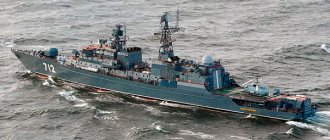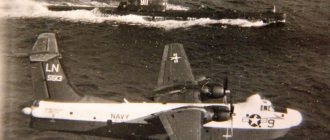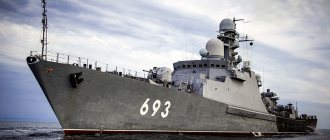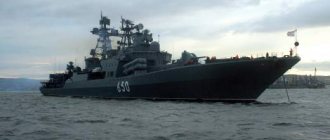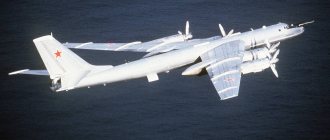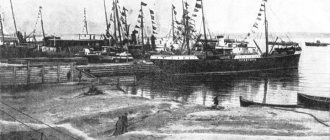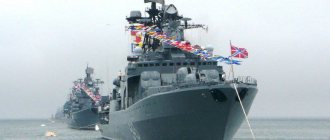Ships of the coastal or near sea zone in the Russian Navy today are represented by a whole cohort of modern combat ships equipped with powerful and powerful weapons. The patrol boats today not only worthily represent the St. Andrew's flag in the open seas of the Black and Baltic seas, but also carry out a huge amount of work in the closed maritime theater. Project 11661 patrol ships “Tatarstan” and “Dagestan” today form the basis of the combat power of the Caspian military flotilla, being the most powerful combat units in the Caspian Sea.
This type of ship was created over a long period of time and was only realized in metal at the beginning of the new millennium. Accordingly, the new patrol boats absorbed all the best that domestic shipbuilding had at its disposal. The SKR, according to the new classification - corvette, project 11661, can rightfully be considered the most modern and combat-ready ships in the Russian Navy.
Design history
Project 1135 began development between 1964 and 1966. The work was managed by the Northern Design Bureau. The new ship was assigned a wide range of tasks, along with escorting convoys through difficult areas in which military operations are taking place, solving tasks to combat enemy submarines and providing air defense for convoys and formations of ships.
Due to the fact that the displacement should be smaller compared to projects 1134 (large anti-submarine ship), helicopters were not envisaged on these ships. However, it was planned to equip them with modern missile systems capable of hitting not only submarines, but also surface targets.
Service
On March 6-12, 1973, with a group of ships of the TFR "Smartivy", he visited the port of Latakia (Syria). From October 4 to November 26, 1973, he was in the combat zone in the Middle East, escorting Soviet and Bulgarian transports. Being part of KUG-5, together with the cruiser "Murmansk", the TFR carried out surveillance in readiness for destruction in the event of the outbreak of hostilities for the aircraft carrier formation of the US Navy, led by the aircraft carrier CVA 42 "Franklin D. Roosevelt".
From September 26 to October 1, 1973, the military-industrial complex, as part of a detachment of warships under the flag of Admiral V. S. Sysoev, made calls to the port of Split (Yugoslavia), from August 9 to 13, 1974 - to Varna (Bulgaria), and from June 26 to July 1 1980 - to Tunisia. On August 30, 1974, Smetlivy provided assistance to the emergency military-industrial complex Brave.
In 1981, the Smetlivy military-industrial complex (board number 745) participated in a demonstration exercise on the automated control of attached and naval aviation forces from the FKP on the Kyiv aircraft carrier. Before being put into repair and modernization, the ship participated in ten major exercises and completed twelve combat duties, leaving over 320,000 miles behind the stern.
Beginning of project 1135 "Burevestnik"
As noted above, the new patrol ships, which were given the name Project 1135 “Burevestnik”, were designed at the Northern Design Bureau (TsKB-35, Leningrad). The tactical and technical characteristics of the patrol ship (abbreviated SKR) were supposed to provide anti-aircraft and anti-ship defense of ships and transports in the near sea zone, guaranteed to destroy enemy aircraft and cruise missiles at low altitudes. The leadership of the USSR Navy issued technical specifications for the development of a new series of ships in 1964.
Construction was supposed to be carried out in 3 places, namely in Kaliningrad (Baltic shipbuilding), Kerch (), Leningrad (). The number of Project 1135 ships was planned to cover the needs of all four USSR fleets.
Features of the TFR
The Project 1135 patrol ship provided a range of up to 4,000 nautical miles at a speed of 14 knots. The maximum speed was in the range of 32 knots with a displacement of 2800 tons. The TFRs were equipped with modern gas turbine and power plants.
New ships were required to provide acceptable conditions for the crew. The project provided for the presence of double cabins for officers and midshipmen, two sailor canteens, and a galley. For sailors, cockpits were created in the bow and stern compartments to accommodate from 10 to 15 people in each.
The created ships have earned high praise from experts. SKRs ride the wave perfectly, their flooding and splashing in all speed ranges is minimal. The use of weapons is possible without problems at any speed, including when the sea state is 4 points. When using anti-roll devices, weapons can be used when seas are more than 5 points.
The unsinkability of the TFR was achieved by the fact that the ship's hull was divided into 14 waterproof compartments. Specialists laid down the conditions so that the ship could provide buoyancy if 3 adjacent compartments or 5 non-adjacent ones were flooded.
The TFRs were equipped with sufficient means of rescue: a motor boat; 6-oar yawl; 20 emergency rafts PSN-310.
The propulsion system is two M-7K gas turbine units. The power of each is 24,000 horsepower. They were located in pairs in adjacent engine rooms.
In addition, there was an energy supply system: a gas turbine unit consisting of a main turbine with a capacity of 6,000 horsepower; afterburner gas turbine unit with a capacity of 18,000 horsepower.
The maximum fuel supply ranged from 450 to 550 tons. If the ship was at full speed, then 390 kg of fuel was consumed per mile, while the range reached 1300 miles.
Project 1135 standard weapons
A typical Project 1135 patrol ship was equipped with the following weapons:
- Two twin 76 mm turret artillery mounts. They were located at the stern. The ammunition load included 500 rounds per barrel. They were delivered from the cellar, which was located under the tower. The gun mounts were armored. Armor thickness - 5 mm. They ensured a rate of fire of 40-45 rounds with one barrel, which should then be cooled for 3 minutes with sea water. The barrel of the installation itself had to withstand 3,000 shots before it completely failed.
- Two Osa-M short-range air defense systems. One was located in the bow of the ship, the second in the stern. They were located in special deck cellars, where the combat kit was also located (24 anti-aircraft guided missiles for each complex). The missiles were installed in 4 drums, 5 pieces in each. The recharge was carried out in 20 seconds. The rate of fire of the complex is 2–2.8 rounds per minute, depending on the type of target (air, surface). The complex detected targets at a range of 25-30 km, while the detection altitude corresponded to 3.5-4 km. The minimum altitude at which target destruction was guaranteed was 60 m above sea level.
- One opposite complex URPK-4 "Metel", which was located in the bow of the TFR. The set consisted of 4 torpedo missiles. When a torpedo was launched, it separated from the rocket at a given point and carried out a parachute splashdown. Then it plunged into the depths, searching for the target of the homing system. Its depth is designed to be 400 m, the speed in search mode is 23 knots, and when aiming at a target, 40 knots. Range 8 km.
- Two RBU-6000 Smerch-2 rocket launchers. They were located in the bow of the ship. The ammunition was in the cellar, and the barrels were loaded remotely. The target operating range was from 300 to 5800 m. The target was hit at a depth of 15 to 450 m. The submarine was guaranteed to be destroyed when a bomb exploded at a distance of up to 7 meters.
- Two 533-mm torpedo tubes ChTA-53-1135. They were located along the sides of the ship. The warhead of the torpedo weighed 500 kg, and the torpedo itself weighed 2.1 tons. Its speed was in the range of 40-43 knots. Range 19 km, depth 12 m. Each torpedo launcher had 8 pieces of ammunition per vehicle.
- 16 IGDM-500 mines. To simplify the installation of the mine while the ship was moving, special rails were used. The depth range at the site of their installation was from 8 to 35 m.
Project 1135 ships were also equipped with jamming installations, various fire control systems, radiation stations and other necessary equipment.
The main performance characteristics implemented in the project 1135 "Burevestnik": displacement of the SKR - standard 2810 tons, total 3200 tons; vessel length 123 m, width 14.2 m; navigation autonomy - 15 days. The crew of Project 1135 in standard terms is 191 people, of which 22 officers, 27 midshipmen.
Aviation
Initially, there was a helipad at the stern of the Smetlivy (which was later dismantled). Shipborne helicopters of the Ka-52 series were an important part of the submarine detection and elimination system. Their main weapons were AT-1/1M class torpedoes with a homing mechanism with an explosive mass of 70 kg. They had the ability to search for the target again if contact with it was lost.
Also, helicopter pilots could drop depth charges of various types. The Ka-25 was also armed with the RYU-2-2 nuclear power plant. It was taken into the aft magazine of aviation ammunition. These aerial bombs were stored in special warehouses in the urban-type settlement of Shchebetovka near Feodosia and were delivered to the 12th berth in Sevastopol immediately before the BOD entered combat service.
Places of construction of the TFR
The construction of ships of the 1135 series was carried out at three factories, namely:
- The Baltic Shipbuilding Plant (Kaliningrad) built 8 ships from 1970 to 1975.
- (city of Kerch) built 7 ships from 1971 to 1981.
- (city of Leningrad) built 6 ships from 1976 to 1979.
The first of the series, the Vigilant patrol ship, was accepted into service by the Baltic Fleet in December 1970.
Currently, all Project 1135 ships in the Russian Navy have been decommissioned. Only the Ladny TFR remains in service.
TFR for the KGB of the USSR
For the needs of the border troops of the KGB of the USSR, a separate project of the TFR was developed. He was assigned the following tasks:
- ensuring patrol duty;
- implementation of security measures in the economic zone of the USSR;
- fight against smuggling.
The developed project in the early seventies became known as 1135.1 “Nereus”. This was a further development of projects 1135 and 1135M. The differences were in the composition of the weapons and the presence on the ship of a helipad and space for placing a helicopter.
It was planned to produce a series of 12 ships. The main area of their application was the Pacific Ocean. The lead ship for border troops was built and commissioned in December 1983.
In total, according to project 1135.1, the following were built: TFR “Dzerzhinsky”; TFR "Eagle"; TFR "Anadyr"; TFR "Kedrov".
Work on the border series was stopped during the collapse of the USSR. Of the three ships laid down at this time, only the Kirov SKR was completed. It was commissioned in April 1993 and adopted by the Ukrainian Navy. Now this ship is the flagship of the Navy of this country under the name U130 “Hetman Sahaidachny”.
The designs of the border ships did not actually differ from the standard 1135. The main difference was the hangar and platform for the Ka-27 helicopter.
According to experts, the border ships of the 1135.1 series had very powerful weapons, which were not usually equipped with coast guard patrol ships. However, this could be explained by the fact that during the design of border TFRs, incidents repeatedly occurred in various areas of the ocean where fisheries were carried out in the interests of countries. As a result, some maritime states sent warships there to ensure the protection of their fishermen.
Repair
Structurally, it was possible to carry out unit repairs of gas turbine units and replace gas turbine engines in a short time. During the design, the dimensions of the gas outlet pipes were chosen both based on the reduction in the temperature of the exhaust gases in the casings, and the possibility of quickly replacing the assembled GTZA M-3 and GTU-6 through them, without dismantling adjacent equipment and opening ship structures. The aggregate replacement of individual elements of the gas turbine engine could be carried out just as easily, thereby greatly facilitating repairs even by personnel.
Modern history of the project
In the period 1999-2013. According to project 1135.6, 6 Talvar frigates were built for the Indian Navy.
Since 2010, in the interests of the Russian Navy, a program has been implemented to launch the updated project 1135.6 (1135.7). This is a deep modernization of the Project 1135 patrol ship. Low visibility technologies are used in its manufacture. The equipment is made on a modern element base. The weapons are advanced and extremely effective systems.
Currently, the Yantar Shipyard has an order for the construction of 6 ships, namely: the patrol ship "Admiral Essen", "Admiral Grigorovich", "Admiral Makarov", "Admiral Butakov", "Admiral Istomin", Admiral "Kornilov". The first three have been put into operation. The rest are under construction and sea trials.
Of this group, the patrol ship Admiral Essen, based in the Black Sea, is known for having repeatedly launched Kalibr missiles against ISIS militants in Syria during missions in the Mediterranean.
Exploitation
In the last years of the existence of the USSR, three ships of the project were laid down in Kaliningrad - Neustrashimy, Impregnable and Tuman. Only Neustrashimy managed to complete construction and commissioning. The construction of his “sisterships” has actually stopped.
Only after some improvement in the economic situation, in 2003, it was decided to complete the construction of the second ship, which by this time had changed its name.
For some reason, the “traditional” name “Unapproachable” was changed to the name of a prince who had nothing to do with sea voyages. Completion dragged on for several years, and only in 2009 (20 years after its laying) “Yaroslav the Wise” entered combat formation.
“Fog” was the least fortunate of all. They tried to interest foreign buyers with this frigate; they even prepared a completion project according to a modified, “export” project. However, there were no buyers. After the completion of the Yaroslav the Wise, they also did not begin to work on the Fog, saying that another frigate “does not fit into the development strategy” and therefore is simply not needed. It was reported that in 2016 they decided to dispose of the Tuman hull.
In 2008, the Neustrashimy received its share of world fame - it was sent to patrol off the coast of Somalia to protect merchant ships from pirates. There he used weapons at least three times, repelling pirate attacks. In 2010 and 2013, combat duty in the Gulf of Aden continued. The patrol ship is currently undergoing repairs. In 2016, “Yaroslav the Wise” also set out to fight pirates, but by this time their activity had decreased, and this campaign did not receive such wide coverage in the media.
Historical facts
In November 1975, the commander of the TFR ship Storozhevoy, V. Sablin, raised the flag of the “coming communist revolution.” He actually captured the ship and made an attempt to enter Leningrad and anchor on the Neva. He put forward demands to give him the opportunity to speak live on Central Television, as he wanted to convey to the people the truth about the situation in the country. However, on November 9, the Watchdog was surrounded by border ships, obstructed its movement by dropping bombs along its course, and fired artillery at it. Sablin was arrested, taken to Moscow, tried and shot.
Another well-known case is related to the TFR “Selfless”. On February 12, 1988, two American ships Yorktown and Caron entered the territorial waters of the USSR near the city of Yalta (Crimea). After unsuccessful warnings about the inadmissibility of crossing the USSR border and demands to leave territorial waters, the commander of the Bezzavetny TFR launched two attacks on the stern of the Yorktown, causing damage to its equipment and side plating. As a result of the incident, American ships left the territorial waters of the USSR.
TFR "Zadorny" (Northern Fleet) is known for having made numerous trips to the shores of America during its service until 2005. Repeatedly recognized as the best ship of the Northern Fleet.
Investigative Committee of the Russian Federation
Let's return to more meaningful abbreviations. The Investigative Committee of Russia or ICR is a Russian federal government body that exercises a number of powers in accordance with the legislation of the Russian Federation, mostly in the field of criminal proceedings. This is a state paramilitary institution formed on the basis of the Investigative Committee of the Russian Federation on January 15, 2011.
There are three types of civil service within it: federal civil, military, law enforcement. The RF IC has the authority to conduct a preliminary investigation in the form of a preliminary investigation. The activities of the Investigative Committee of Russia are led by the President of the Russian Federation.
The functions of the Russian Investigative Committee are as follows:
- forensic activity;
- procedural supervision and other control over the activities of investigative bodies;
- preliminary investigation (within the framework of the law) of criminal cases;
- forensic support for investigations of a number of crimes;
- pre-investigation check as a response to reports of crimes that come directly to the Investigative Committee;
- other functions assigned to the Investigative Committee by the legislation of the Russian Federation.
